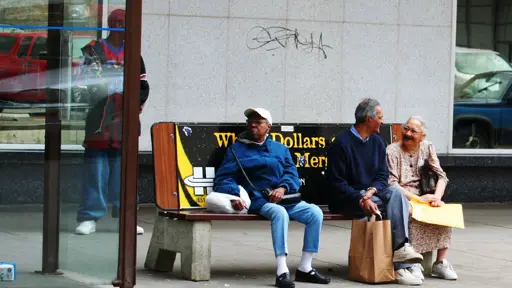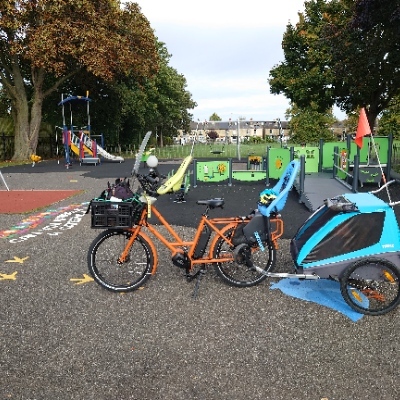According to the U.S. Department of Transportation, approximately one-third of the nation’s residents don’t have driver’s licenses. In her 2024 book “When Driving is Not an Option: Steering Away from Car Dependency,” disability advocate Anna Zivarts argues that not only is America’s car-centric infrastructure harmful to the climate, it also fails to meet the everyday needs of many Americans.
because we hate poor people
And car makers sucessfully managed to lobby for it in the last 100 years.
Even the Netherlands was turned into a car centric country after WW2, it’s just that people fought back against car centric design starting in the 1970s because they realised how bad it is for everyone.
The USA helped rebuild a lot of countries after WWII through the Marshall Plan, which is probably partly why so many ended up with car-centric infrastructure.
A third of Americans don’t drive. So why is our transportation so car-centric?
A critical disconnect between policy and reality.
I mean why are we still asking why? We know why. The American dream involved a house and a car. The great American road trip. The lack of high speed rail. All of that got us here. The real question is what’s keeping us stuck here? And the answer is politics. Solve the oligarchy issue and you might be able to take on the projects we’re need to do away with car centric culture. Get people in office that value infrastructure over military might, and will stop subsidizing car and gas companies. A small thing any of us can do is, when job searching, require companies to justify why a job must be in office instead of remote and unless it makes sense, don’t accept in office requirements. That last one is arguable more difficult if you’re in desperate need of a job, but in other conditions, try it.
I drive as well, and I hate it every time. I drive because I “have too”.
If there was quality rail, subway, tram, and regional bus service that was within a five minute walk I would choose it any day.
There something about being chauffeured around that so much more relaxing and stress free.
Unfortunately, the car centric argument always seems to be more public transit would take away from people desire to drive, but on the contrary it would make driving less stressful. Less cars “in your way” or on the road and local streets.
Commuting is all about avoiding crowds. I love driving, I just hate traffic. It’s so mainstream so all the joy is gone.
Trains are amazing when it’s not packed. You can look outside, have some drink, use your phone without getting motion sick.
Busses are pretty wild, not my favourite. If you see a bus in Belgium, do not play a dare with them. You will die.
E-bike is amazing if you have a road without cars. Which is what I do now. 28,7 km a day. Decent exercise too. The off road part is pretty fun. Bit of a game to be honest.
Honest question; how is an E-Bike decent exercise? I’ve never used one before.
It says I burn 450 calories a day for 28,7 km. So when I ordered the bike, I started going to work with a manual bike just to get used to it.
The difference is clear. My knees hurt for 2 weeks, my quads were lightly sore the whole time. When I arrived, my back would be wet from sweat.
But I would be a lot slower, I’d be taking a lot of breaks between pedalling. The hills would take a lot of energy, like it’s a squatting set.
When doing cardio, it’s important to be consistent.
The bike I’m using, never tried any other e-bike, is the R&M Multicharger2 GT Rohloff.
I’m always on the automatic mode. With the system that it has, it adjusts how much power it assists with.
The bike weighs like 30 kg.
Going up hill is very easy, it automatically shifts to a lot of assistance. Then it stops doing so.
Braking doesn’t feel like a pain in the ass anymore, so it’s a lot safer for pedestrians. On a manual bike you’d hate braking because getting started is a huge waste of energy. With this thing, you just shoot ahead quickly and then it stops assisting until you get in higher gears.
You can handle the bike quite well, as you can use your pedalling to adjust the speed. You can easily go at walking speed and you easily can go to max assisted speed or in-between.
It’s a lot easier to choose your own speed than my wife’s la souris scooter.
For the burning calories part, I asked yesterday le chat mistral why. It said that because it helps you stay at top speed for the whole ride, you take no breaks, it just keeps you consistently into the same burning mode.
I often go at 26 to 29 km per hour. It only assists to 25 km per hour. If it’s a flat road, it will minimally assist. The bike is 30 kg, I’m 90 kg. It’s still a good workout. When I get tired, I can keep pedalling, I just go to 25 km per hour at minimal assistance. Until I can go faster again.
With a manual bike I would have to really just lower the gears and rest up for a while, dramatically lowering my intensity and speed.
Hope this helps
OMG I’m such an idiot. I thought e-bike was like an e-scooter. Thank you so much for clearing that up!
Nah, like for an e-motorbike there’s like 5 KW needed as battery and it lasts like 60 km. (The vehicle weighs like 120 kg) and goes usually like 75 km/h.
While my e-bike only has a 0,75 KW battery and lasts 90-100 km.
The pedalling lowers the amount of energy needed by quite a bit.
That and speed. Higher speed - higher energy usage. Not only does e-bikes go 25km/h (compared to ev motorbikes 75km/h), but also, like you mentioned, part of that is supplied from your muscles.
All in all, ev motorbikes are just glorified scooter as of now.
Yeah they need some improvements, but they are far less subsidised so it makes sense in my area at least.
@k0e3 @Wanpieserino depends on the type, but in Europe it’s only legally an ebike if the battery only assists pedalling - no throttle, no working if you’re not pedalling - and cuts out after 15.5mph/25kph (anything more is a motorbike). So it takes the edge off hills, helps at junctions etc, but you’re still going to have to work while on it. https://www.bikeradar.com/advice/fitness-and-training/electric-bike-fitness
Also it takes away that initial “ugh I can’t be bothered, I’ll drive” so you end up cycling more in general.
5 minutes is small even for many transit centric countries. Try 10.
Becau$e
$$$
Just because people don’t drive, doesn’t mean they’re not traveling by car.
Is a bus a car?
No, it’s public transport. Unless you want to use a wider definition that includes train cars as well.
20% of Americans are children under the age of 18 and so don’t need to drive…
So the other 66% are driving.
That leaves only 14% of people who refuse to. I’d say that’s a pretty good reason to have a car-centric nation.
This isn’t Europe where everything is within walking distance of you, and it’s infeasible to do such a thing here in America.
So 66% are driving.
No, 66% having a drivers license, doesn’t mean 66% drive. And even those who usually do, can’t drive all the time. There are a lot of reasons why you might be unable to drive, even if you have a license: Being drunk, being sick/injured, being to old to safely drive, being to tired to safely drive, being to broke to afford the gas…
And even of those who do drive, a large percentage might not drive because they want to, but because they are forced to drive due to a lack of walking, cycling and public transportation infrastructure.
This isn’t Europe where everything is within walking distance of you, and it’s infeasible to do such a thing here in America.
It doesn’t matter how big your country is. Nobody in their right mind drives from New York to San Francisco on a daily basis, not even from New York to Philadelphia.
The vast majority of commutes are from your home to the local school, the local supermarket or the local workplace within the same town. A distance that could easily be traveled by bike if there was any bike infrastructure even in today’s US cities. Granted, the distance you have to travel to get to these places is usually bigger in the US, than in Europe, but that’s only because you don’t have mixed neighbourhoods. And you don’t have mixed neighbourhoods because every little convenience store needs to be surrounded by 200 acres of parking because you can only get there by car.
@brotundspiele @kitnaht
Grammar Correction: Too, to and two are not interchangeable.
Correct usage: He was too old, too drunk and too sick to drive two blocks to the store. Two dollars is too much to pay.I fully agree with you and #FuckCars
Normally I know that, but I guess I was just two tired while typing 😂
20% of Americans are children under the age of 18 and so don’t need to drive…
Your childhood must’ve been very different from mine! I needed to get places as a kid, like school, friends’ houses, stores, parks, the library, and more.
@SwingingTheLamp @kitnaht In a functional community, kids can get to all those places by walking or biking. Sorry your parents raised you in sprawl hell instead of a real neighborhood.
Ah, but that’s the issue highlighted in the article: Most of the United States is not a functional community.
Seriously, people get so triggered and come in here saying the most ignorant shit. It’s actually worse than the vegan communities for how often it happens.
They still need a way to get around any transport would make that easier
And transport still needs what…think that through a little more…
The roads for mass transit are the same as they are for individual transit…and they aren’t specialized, they’re universal. A small car, bike, bus, or semi can all drive on the same road.
A train track can only be used by a train. Sidewalks can only be used by pedestrians and maybe bikers.
A road however – can be used by all shape and size of transport; including the transport that the last 14% need.
Sure, a bike can use the same roads cars are using. Have fun with that.

Btw. a train track can be used by cargo trains, passenger trains, trains carrying cars, trains carrying bikes, etc. If you build decent bike lanes, they can even be used by ambulances to skip traffic.

deleted by creator
This doesn’t seem like a good-faith argument, because this is a pre-schooler’s take on transportation issues. Anybody with a passing familiarity with roads can see the holes in it.
Rails & trails. We have spent the last 50 years building “one more lane” to solve traffic & all it does is incentivize more cars. Roads don’t promote high density travel like a proper bike network in a city or a commuter rail network to connect suburbs together.
20% of Americans are children under the age of 18 and so don’t need to drive…
That’s nonsense. Nearly everyone under 18 needs transportation.
America isn’t Europe, but just like in Europe, most American trips are really short
You mean like New York where everywhere is clogged with taxis? Rather than people driving themselves, somebody else is.
Taxis are immensely more efficient space wise than individual people owning cars.
The average car is parked 97% of the time. If we took taxis away from NYC and didn’t compensate with public transport , they’d probably have to replace central park with a massive parking lot. Not kidding.
They are, my only point was no drivers license doesn’t equal not traveling by car
I think this perception is a little inversed or skewed IMO. The congestion is caused by individual cars which block the transit and taxi routes.
The Transit is needed, otherwise more cars need to be added to the road. With increased transite, more cars are removed from the road.
From what I have seen based on the congestion charges implemented in NYC as a example, it’s dropped the number of personal vehicles commuting into the city at any given day. This in turn has dropped the congestion, while in turn dropping taxi commuting times.
Things like congestion charges are a artificial incentive to carpool, take transit, or split the cost of a cab. This decreases the amount of cars while keeping the amount of commuters roughly the same.
Now you could argue with more of the road now “open” or “free”, what stops more taxis from being added to take advantage of a increase in demand for quicker travel.
Of course transit is needed. I prefer it. I was only commenting on why we are still carcentric even if people don’t have drivers licenses, people still use uber and taxis (car centric) instead of a bus or subway. Either routes and service are not enough, or people are uses to immediate needs serviced and don’t want to wait at a busstop
New York is more than like midtown manhattan. I would not describe it as “clogged with taxis”.
Also there’s like 3.5 million subway riders per day in NYC.
So I don’t know what point you’re trying to make.
The article of “1/3 people don’t have drivers licenses so why are we so car centric”. People still use cars (as taxis) without a drivers license. Having no license does not mean you solely rely on transit.
I’m pretty confident that most people moving around NYC are not taking a taxi on the daily. I’m guessing you don’t live here.
You missed the point of what I was meaning. The article was eluding to people without licenses should mean leas reliance on cars. But Uber exists, taxis exist, car pool exist. Just because a person doesn’t have a license does not equal not traveling by car.
Not having a driver license doesn’t mean not driving. It just means driving without a license in many cases, often also without insurance.
In some cases, these are immigrants who cannot get a driver license without having a legal status. IMO, we should make it easy for these people you get a license and insurance.
In other cases these are bad drivers with suspended or revoked licenses due to serious violations. The rest of us would benefit by their having a public transit option that works.
There’s no way those numbers change it drastically from “about a third”.
We should not make it easier to drive, we should make it easier to get around without needing to drive.
Yeah, that’s kind of a weird way to look at it because the inverse is also true: having a driver’s license also doesn’t actually mean someone drives. I don’t own a car, but have a license. I walk or take the bus for most of my transportation needs, but renew my driver’s license so that I have the option to rent a car for the rare situations where it makes sense.
Why the immigrant perception? Seems to feed the propaganda of “immigrant bad”.
I agree with your point, but there are plenty of reason someone would choose to drive without insurance. It does not necessarily mean they are automatically an immigrant.
Can we please focus our energy on more clear and present problems like the fascist takeover that’s happening?
In the fuckcars community?
The problems poor people have been dealing with for decades have to wait because now, YOU have problems, and they’re ever so much more important than the ability of people to function at a basic level. Please, go ahead, fucking solve fascism.
There is a long history of connection between cars manufacturers and fascists, to be fair. But beyond the history involved in them, car centric design contributes to it: Mass resistance is more difficult with physical separation, which driving promotes. Inefficient use of resources promoted by spread out design, and a requirement to buy, fuel, and maintain an expensive vehicle make people in even wealthy societies poorer, and people struggling to maintain a formerly comfortable quality of life are exactly the kind of people that fascists like to recruit, as they can often be convinced to blame scapegoat groups for their struggles and yearn for older times that the fascists can promise a return to.
Im not suggesting the one is entirely to blame for the other, you can certainly have fascists without car dependence, and cars without fascists, but they contribute to the conditions that fascism can take hold in, and make life easier for such regimes once installed.
One of the tests that Strong Towns offers to determine whether your town is a strong one is this: If there was some emergency (say, a fascist takeover) that required the community to gather together, would people know instinctively where to meet? In lots of low-density, car-oriented landscapes, there’s no there there, no community/symbolic spaces where people would go.
Obviously, this is an analytical tool, not guide as to what would happen in any real-world scenario. It does highlight the decline of community, and the fraying of the weak social ties that hold a community together. How do we as Americans organize ourselves to resist when so many of us don’t know even our close neighbors? How do we work to reduce political polarization, which is done by daily, face-to-face interaction with people who are not like us, when we have so little community interaction that’s not through a windshield?
It’s a chicken-and-egg problem as to whether the destruction of community is a cause or effect of car-dependency, but what’s clear is that the fascists are here and taking advantage of the fact that we’ve fucked ourselves over with a car-dependent landscape for too many decades.
@SwingingTheLamp @orbituary So many of the protests taking place now (especially the Tesla ones) are on 5+ lane stroads where most of the passersby seeing the protest are in cars. It’s a dangerous and inefficient way to fight fascism, but what else do people know how to do in Americar? So many suburbanites don’t even know how to get into city centers for a protest unless the city has been gutted to provide endless free parking.
Geography is extremely pertinent. I want for us to ensure our Democratic freedoms before our conveniences.
In the fuckcars community?
@orbituary @relianceschool You don’t think Americans living in sprawl and spending most of their time driving around alone in ever larger SUVs and monster trucks has something to do with why so many of them turned to fascism?













